Before the Okavango River fans out into its familiar delta shape, its waters are channeled between steep banks created by parallel fault lines. This channel is commonly known as the Pan Handle, named as such as the Delta takes on the appearance of a giant frying pan lying in the heat of the Kalahari.
Permanent deep water has encouraged the growth of villages along the river, particularly on the western side which is accessed by a tarred road. The communities up in this area are mainly fishing based or cattle farming and there are opportunities for some colourful encounters with the locals and the area offers a true glimpse of village life, often not seen in Botswana as guests often only visit the uninhabited wildlife areas.
The Panhandle area is not within a protected reserve or park, but there are still huge areas of unspoiled wetlands and a number of well-established lodges on the western side. The wetlands offer exquisite birdlife , a huge population of hippos and some of the largest crocodiles to be found. The general wildlife common in the lower delta is less abundant in this area. The focus of activities in the area are water based - motorboating and fishing, and it is possible to travel by road or boat to the eastern side of the river where there are community based mokoro excursions offered. The Pan Handle area is also in proximity to the world heritage site of Tsodilo Hills. Being the spiritual home of the San and Bantu people, the hills feature many well preserved specimens of 'rock art' and there is a small museum where it is possible to hire a local guide for a personal tour of the area. The annual barbell run of catfish ( September/October) attract hunting tiger fish in large numbers and is the best time for serous anglers to experience this fascinating phenomenon and catch this awesome predatory game fish.



Looking at a map of Botswana, you’d miss Khwai completely if you didn’t know it was there. Wedged between the big-ticket attractions of Chobe National Park to the east and Moremi Game Reserve to the south, Khwai exists as a significant big game destination of its own.
Lying on the eastern fringes of the Okavango Delta with a rich wildlife population and no borders drawn around it on the map, Khwai is often overlooked in favour of its more famous neighbours, though in the winter months it can hold its own for the quality of big game viewing.
During your time here, you’ll spend most days exploring the narrow Khwai River, which forms the natural boundary to the Moremi Game Reserve on the south. The Khwai River is a beacon for wildlife and plays host to leopards stalking lechwe in the long grass, lions swimming from the banks to save their cubs’ during territorial disputes and crocodiles competing with wild dogs for a midday meal of impala.
As Khwai lies outside the parks, it offers the freedom and flexibility normally only possible with the heavier price tag of a private concession. Go off-road for a closer look at sightings, night drive in search of nocturnal species, and, with a little advance planning, head out on game walks to track wildlife on foot.
Khwai is also home to a village community where people live side by side with the resident wildlife. Some camps will offer village visits for a dose of cultural insight to go with your safari. For those not visiting the water camps of the delta, many camps in Khwai offer the chance to get out on a mokoro (traditional canoe), although excursions are less traditional in nature, skirting the riverbanks, rather than open delta floodplains.
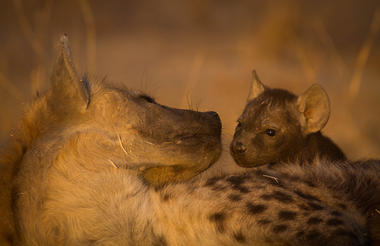
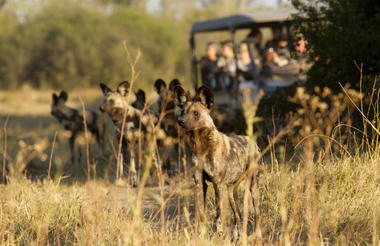
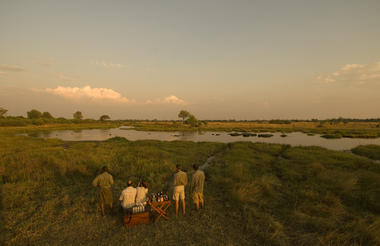
When it comes to Botswana, Savute breaks all the rules: both for animal behaviour and for habitats. Here, lions hunt elephants, leopards take to fishing, the grasslands are vast and open and rocky hills punctuate the flat terrain.
Savute has proved itself somewhat of an enigma over the decades. During years of abundance its marsh fills with water, fed by the Savute Channel. The water weaves its way here from Angola via a chain of rivers and lagoons, spilling out into the marsh and drawing huge herds of elephants, wildebeest, zebras and buffalos.
In drier years, the channel shrinks into small pools and can evaporate completely, leaving the marsh dry and sending wildlife to the waterholes for water, where the tension between plains game and predators heats up over a parched and dusty landscape.
Wherever the plains game goes in Savute, the predators follow close-by, learning tricks of survival to adapt to the marsh’s ever changing nature. Whether the water flows here or not is anyone’s guess. The channel and marsh have a life of their own, independent both of the seasons and the annual rainfall.
Savute doesn’t just offer a safari; it’s also a feast for the eyes. Whitewashed skeletal trees set against green grass and huge blue skies, blinding red sunsets that spill purple and orange across the bush, and endless horizons that fade into a hazy mirage with the heat.
As Savute is part of Chobe National Park, a safari here is limited to game drives only. With the diversity of habitats, wildlife and landscapes that the marsh has to offer however, you’ll still find yourself wishing you had more time to see it all.

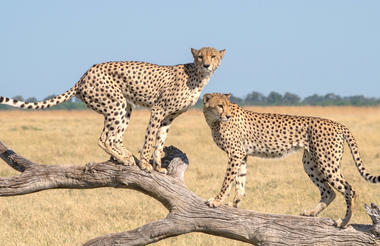
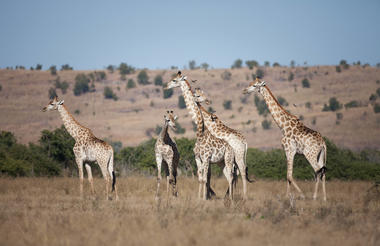
The Chobe River Front is a remarkable wildlife area due to the permanent water source of the Chobe River. However its accessibility from Kasane and neighbouring towns of Victoria Falls and Livingstone has created quite a busy tourist area with larger hotels and lodges than you find in the more remote Okavango Delta. The spectacle of all the animals coming to drink and frolic at the water's edge is one to behold, particularly in the dry season (May - Oct) where water is scarce away from the river. It is an area famous for its abundance of elephants, a variety of predators and, in addition, you are likely to see herds of buffalo and possibly even roan and sable antelope. In the rainy season (Nov - Apr) the game is much less concentrated at the river as the wildlife spread throughout the greater area of Chobe National Park due to availability of surface water from nearby pans. This assists the vegetation on the river banks in recovering from the massive herds that are attracted to the area in the dry months. The summer rains bring beautiful wild flowers, exquisite scenery, impressive bird life and an abundance of young animals usually born around November/December. The spectacular Chobe sunsets alone are worth a visit to the area. Please note that activities are restricted within the national park in accordance with government rules and regulations: these include no driving off-road, no walking and no driving after dark.
Chobe Game Lodge is the only lodge situated within the National Park. The remainder of the lodges, hotels and guesthouses in the Chobe area are located along the river in the town of Kasane, adjacent to the park. In addition there are some lodges situated further out of Kasane and in the Chobe Forestry Reserve, namely Muchenje Safari Lodge and Elephant Valley Lodge for those looking for something in more of a bush setting.
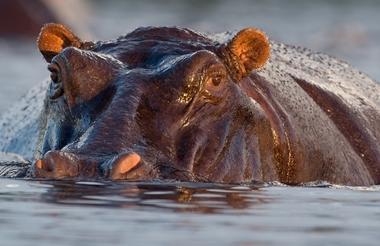


At Victoria Falls, the earth splits open and swallows one of Africa’s greatest rivers, the mighty Zambezi, creating the largest sheet of falling water on earth. As the water hits the narrow depths of the Batoka Gorge beneath, it blasts a cloud of mist skywards, lending the falls their local name ‘mosi-oa-tunya’ (the smoke that thunders). When the Zambezi is its fullest, the mist hangs a permanent raincloud above the falls, showering visitors on even the sunniest of days and visible for miles around.
Above the falls on the upper Zambezi, boats cruise the tranquil water at sunset while the distant spray catches the fading light downstream. Below the falls, the Batoka Gorge’s rocky walls funnel the lower Zambezi into a chain of world-class rapids, prime for white water rafting.
Aside from being a UNESCO world heritage site and a natural world wonder, Victoria Falls also forms a natural border between Zimbabwe and Zambia. The falls can be seen from both countries, and for the most part the same activities are offered on both sides, from helicopter scenic flights to village visits and souvenir shopping.
Whether your idea of getting away from it all is a relaxed high tea in colonial grandeur or a heart-stopping bungee jump off a bridge, Victoria Falls keeps both the faint of heart and the most insatiable of adrenalin junkies busy for days.
From Zambia, a side on view of the falls is on offer with views into the Batoka Gorge, as well as the possibility of perching yourself at the edge of the falls on the vertigo-inducing Livingstone Island.
From Zimbabwe, you’ll get a full-frontal view of three quarters of the falls’ 1.7km wide curtain of water from viewpoints and footpaths meandering through a rainforest kept hot and humid by the spray of the falls.
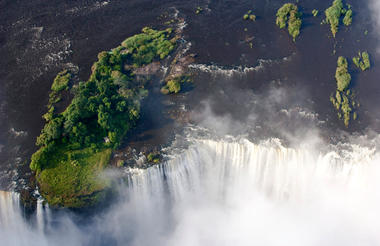
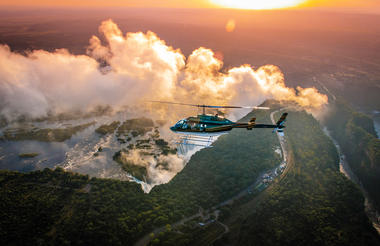
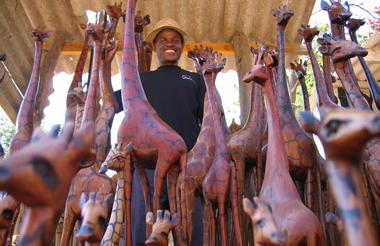
 (1) (002)1.png?fmt=png)


 (1) (002)1.png?fmt=png)
